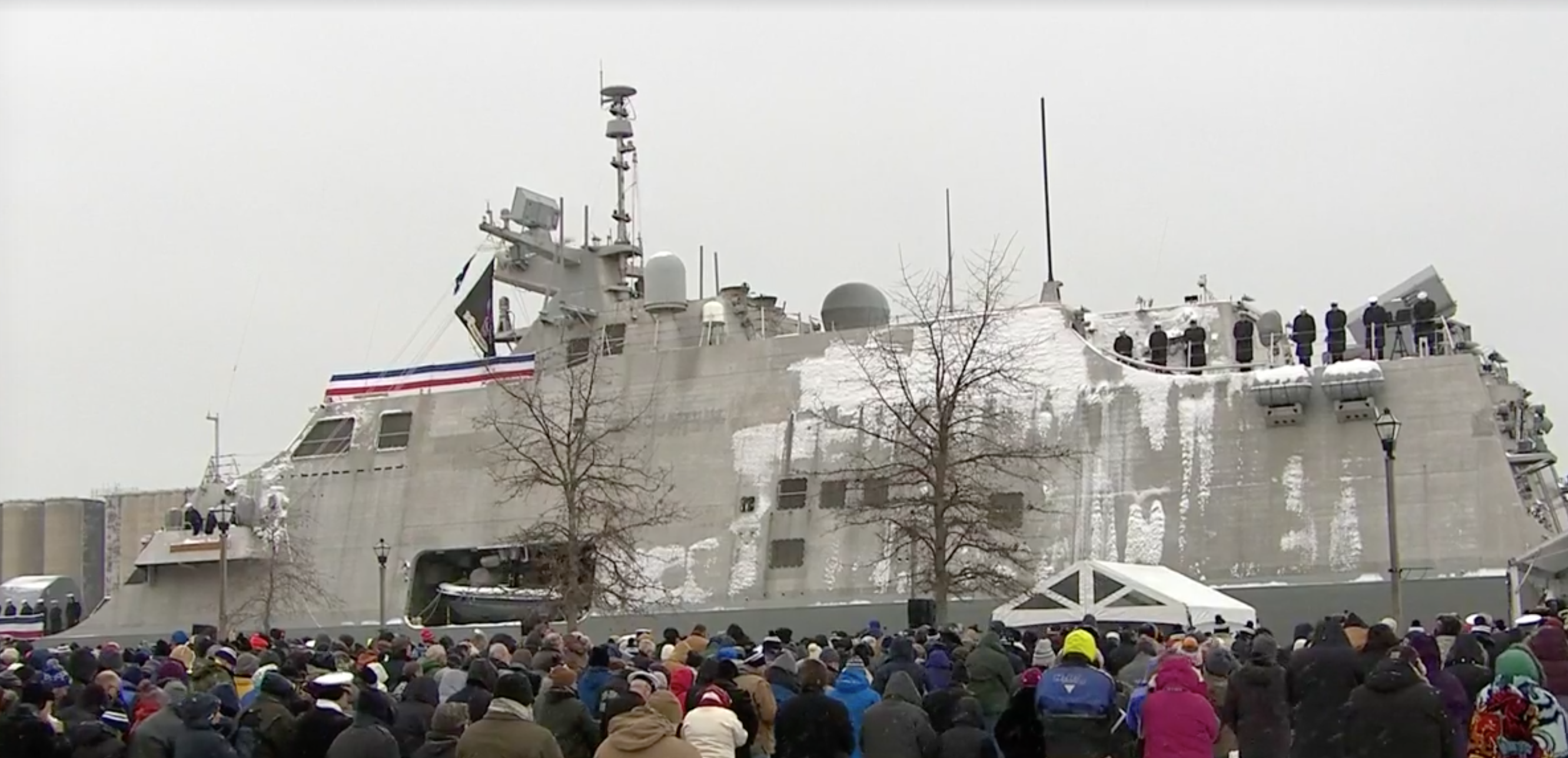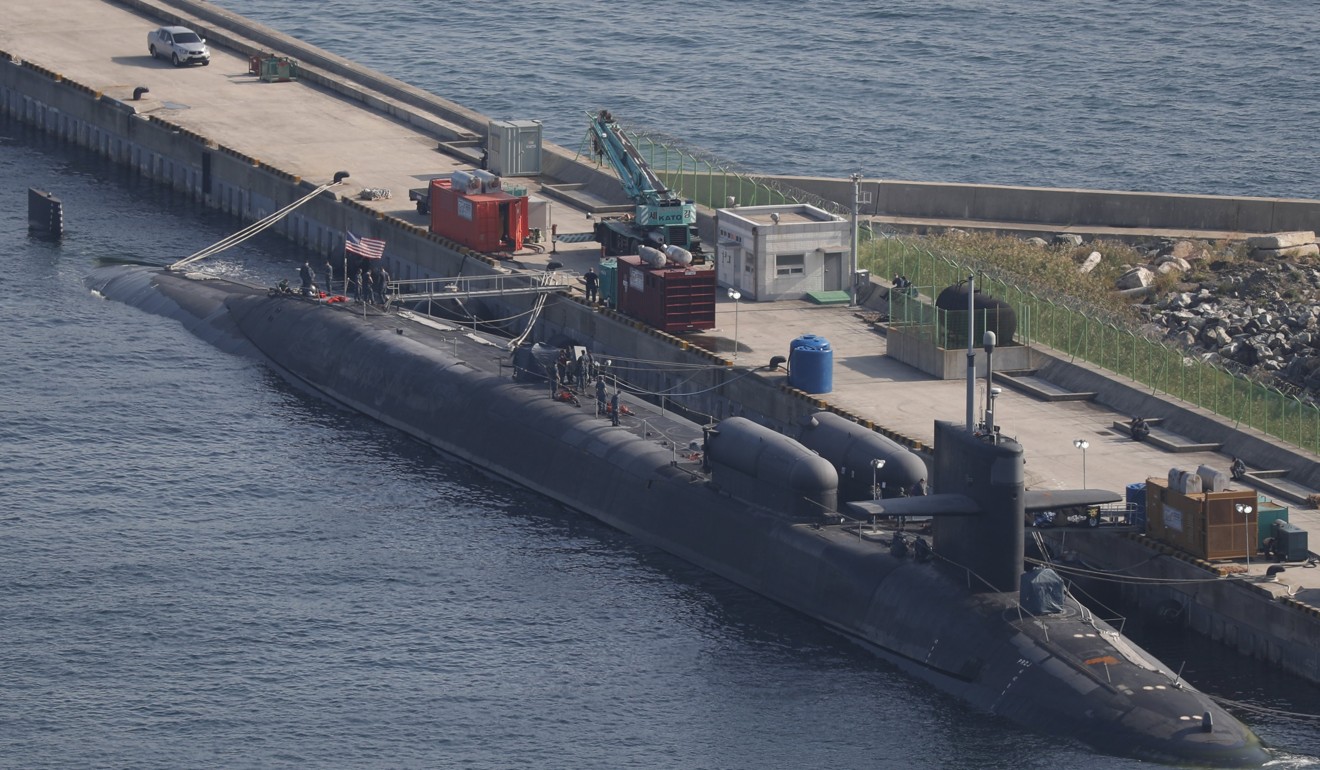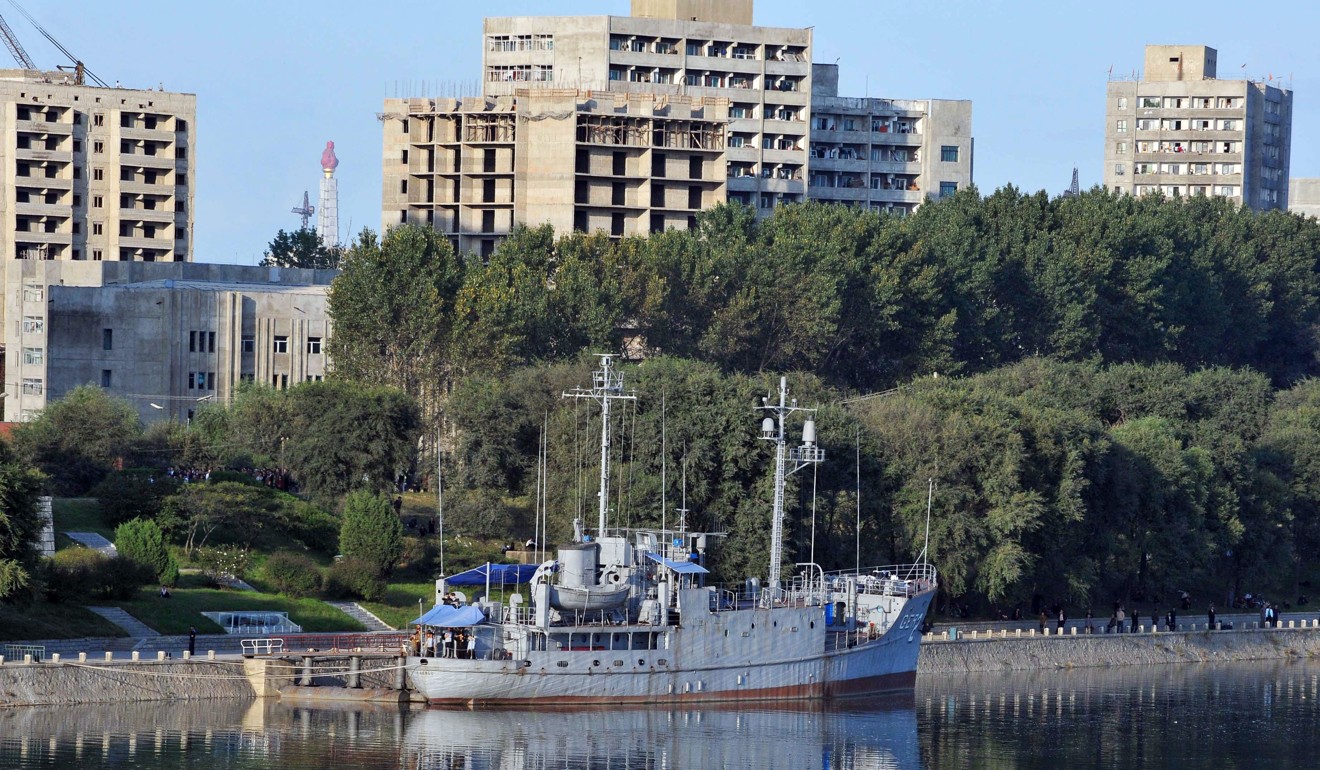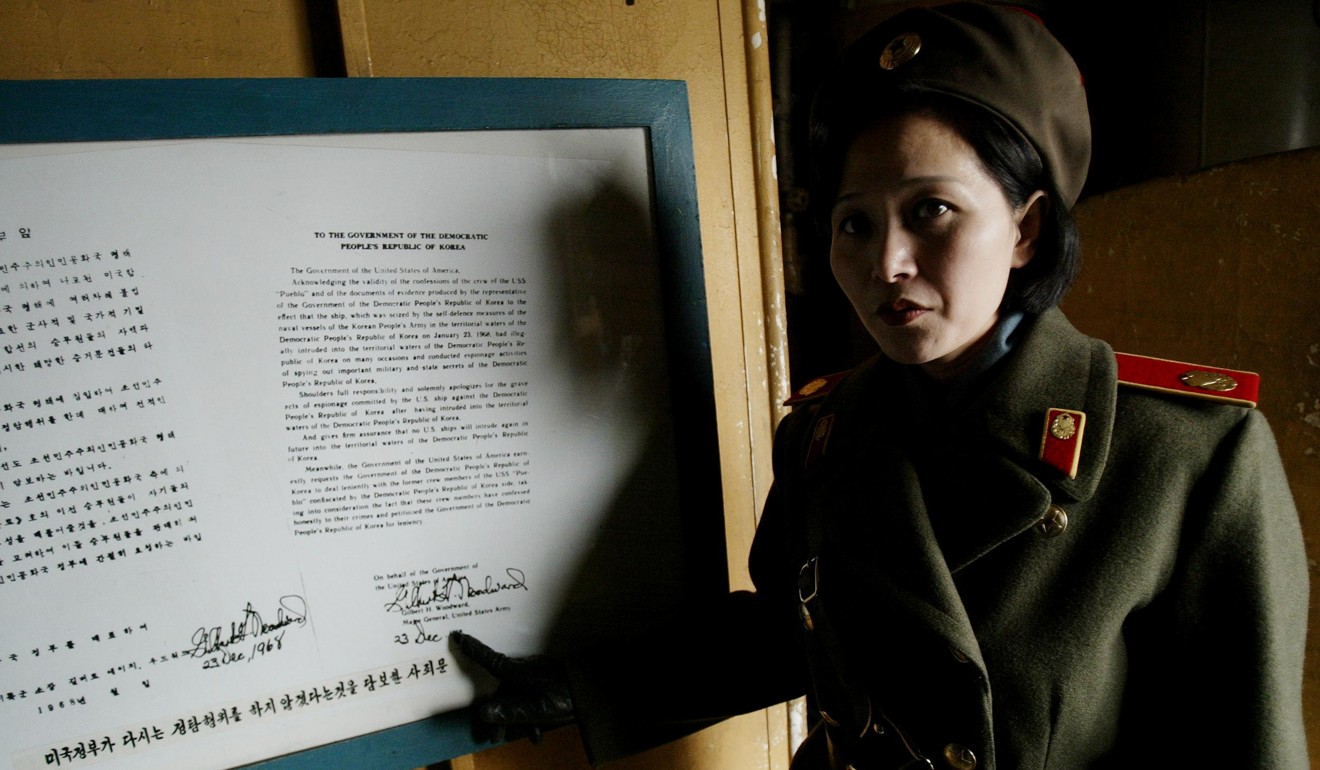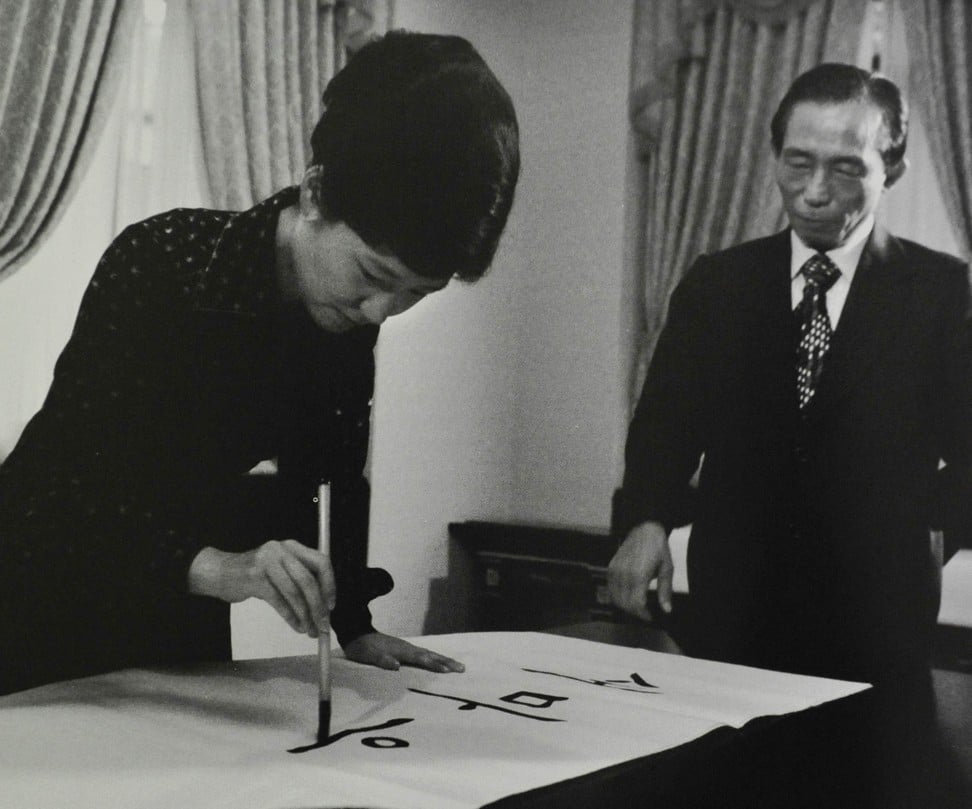The USS Little Rock was only captured by ICE, the USS Pueblo was captured by NK, grandpa of Kim Jong Nuke, today Pyongyang still put it out as an Exhibit to show the public, will Dotard go visit it? :
http://www.scmp.com/magazines/post-.../lessons-today-uss-pueblos-1968-capture-north
Lessons for today of USS Pueblo’s 1968 capture by North Korea
Political experts say there is much to be learned from the warship crisis 50 years ago that brought the Korean peninsula to the brink of a second war
By
Stuart Heaver
25 Jan 2018
14 Share
More on
this story
The United States warship moored on the banks of the Pothong river, in the North Korean capital of Pyongyang, is likely to attract a great number of visitors this weekend. It is not engaged on a goodwill visit nor is it the venue for talks between the two nations, but given the current tensions, it is surprising the USS Pueblo doesn’t draw more attention.
“It’s chilling for an American to go on board; the windows are still cracked by bullet holes, there are the original books and ledgers. It’s meant to be a museum but it’s a propaganda showpiece,” says Jean H. Lee, a journalist, expert in North Korean affairs and global fellow with the Woodrow Wilson International Centre, in Washington DC.
A newspaper clipping of the crew of the USS Pueblo, captured in North Korea.
The ship was an electronic surveillance vessel – a spy ship – and when it was seized, along with its surviving crew of 82, by the North Korean Navy, on January 23, 1968, the cold war was brought to boiling point. The sailors were returned – having been held captive in brutal conditions for 11 months – but the Pueblo, complete with shell holes and left-behind uniforms, has for many years been on display as a reminder of a North Korean victory over its capitalist nemesis.
Six steps to stop a war between North Korea and the US from starting
There are parallels between the Pueblo incident and the crisis now afflicting Pyongyang-Washington relations and “a small amount of miscommunication or misunderstanding of the current rhetoric can lead to a regional military escalation and conflict. That’s what we learned in 1968,” Lee says.
“And it’s just an absolutely incredible story,” she adds.
In his book
Act of War: Lyndon Johnson, North Korea, and the Capture of the Spy Ship Pueblo (2013), author Jack Cheevers describes the affair as “one of the worst intelligence debacles in American history”. His factual account reads like a cold war thriller, as a routine naval surveillance mission in the Sea of Japan rapidly escalates into a diplomatic incident that nearly spills over into war.
US President Lyndon B. Johnson (centre) and secretary of state Dean Rusk (left) in 1968. Picture: Alamy
The erstwhile army cargo ship had been refitted to undertake electronic surveillance missions as part of what the US Navy termed Operation Clickbeetle, which envisaged up to 70 similar ships being dispatched to patrol the coastlines of nations Washington deemed troublesome, listening for radio chatter.
It sailed north from the Sasebo Naval Base, in Japan, on January 11, 1968, for the eastern coast of North Korea. Commander Lloyd Mark “Pete” Bucher – a “tough, charismatic and cheerfully profane” former submariner, according to Cheevers – was given strict orders to stay outside Pyongyang’s claimed 12-nautical-mile territorial limit. The ship was to spend two weeks sailing up and down the North Korean coast looking for the coastal anti-aircraft batteries the Americans believed the North Koreans had been constructing and any of four submarines Moscow had recently delivered to Pyongyang.
‘North Korea is a time bomb’: government advisers urge China to prepare for war
Bucher had at first apparently not been enamoured with his assignment. But as Simon Winchester writes in an account of the incident in
Pacific (2015), the fact that “the full might of the US Navy in the Pacific might well not be able to reach him should he ever get himself into trouble thrilled the young captain’s gung-ho side. He was a man eternally eager for adventure, a show off notoriously given to braggadocio and fond of derring-do”.
The USS Pueblo on January 23, 1968. Picture: AFP
The Pueblo was given the official designation AGER 2 (Auxiliary General Environmental Survey), which was painted in white on her bows, in order to disguise her sensitive role, although the forest of antennae and radio masts above the superstructure would have been a giveaway. Spy ships were an open secret during the cold war and the Soviet Union had been using a large fleet of converted fishing trawlers for that purpose for years.
The Pueblo’s deployment was relatively uneventful until noon on January 23, when Bucher’s lunch was interrupted by a report from the bridge that a vessel was closing in fast. When a North Korean submarine chaser was identified, Bucher instinctively double-checked his navigational position and confirmed the Pueblo was inside international waters. He braced himself for some routine intimidation but did not order the canvas covers to be removed from the ship’s two small-calibre machine guns. Such a move might appear provocative from a “research ship” conducting its legitimate business on the high seas, he reasoned.
The USS Michigan (SSGN 727), the US Navy’s nuclear-powered guided missile submarine, is docked in Busan, South Korea, in October. The submarine arrived in South Korea amid North Korea's nuclear and missile provocations. Picture: EPA
Bucher ignored the North Korean flag signal to “heave to or be fired upon” and replied that he was “in international waters and intended to remain, if feasible”, all the while transmitting radio messages back to Seventh Fleet Command, requesting urgent assistance.
“We were so highly classified no one knew who the hell we were,” Bucher would tell Diane Sawyer, of ABC News, in an interview to mark the 30th anniversary of the incident, in 1998, six years before his death.
The situation escalated rapidly: by 1.15pm, the sub-chaser had been joined by three motor torpedo boats (MTBs) while MiG aircraft screamed overhead. Bucher kept his nerve and headed further out to sea. The 176-foot former transport ship had a maximum speed of only 13 knots, so there was no chance of outrunning or outgunning anything. With options disappearing fast, Bucher ordered immediate destruction of surveillance equipment and all classified data and publications on board.
The sub-chaser opened fire with its 57mm gun from close range while the MTBs raked the Pueblo’s decks with machine-gun fire, and their crews attempted to board. One American sailor lost his life as burning hot shrapnel flew through smoke-filled compartments. Bucher continued in his efforts to buy time while his stunned crew burned or ditched sacks of confidential documents to prevent them from falling into the hands of the North Koreans.
The Pueblo was boarded at 2.32pm.
US naval uniforms on display aboard the Pueblo. Picture: AFP
What Bucher had not been told was that the hostile South-North relationship on the Korean peninsula had reached a febrile state just as the Pueblo had arrived on station. An audacious assassination attempt on South Korea’s president Park Chung-hee had been undertaken by 30 North Korean commandos, in the centre of Seoul, the day before (see sidebar below). The so-called Blue House raid, although unsuccessful, had put both sides on a war footing.
So, at the height of this tension, the US Navy abandoned a lightly armed surveillance ship just 15 miles from a major North Korean port. The sailors, some wounded, were made to sit blindfolded in freezing winds on the upper deck as the North Korean boarding party searched the vessel.
“In minutes, the Americans had been snatched from the snug, seemingly predictable world of the Pueblo and thrust into a parallel universe of fear and uncertainty,” writes Cheevers, describing how the crew started their 11-month nightmare of beatings, mock executions, starvation, sickness and violent interrogation.
“It was mostly kicking and hitting us with gun butts,” a quietly spoken Bucher would tell Sawyer. “I was rendered unconscious three times on that first day.” The commander would recall an incident when a revolver was held against his head; when the trigger was pulled it “echoed” as it clicked against an empty chamber.
Although the current situation is one of the most severe crises in US-North Korean relations since the 1968 crisis, it is not a case of history simply repeating itself
Brian Bridges, an expert in Korean politics
The North Koreans were desperate to obtain confessions stating that Bucher and his men were undertaking illegal CIA spying missions inside territorial waters. The commander repeatedly refused to cooperate but, after beatings and sleep deprivation, and in constant fear of execution, he was taken to a concrete building where he was shocked by a gory spectacle. Suspended from the ceiling was a suspected South Korean spy. The unconscious man had been so severely beaten, his bones showed through his skin, he had bitten through his lower lip and an eye had been put out. Bucher says he was told his crew would be killed, starting with the youngest and working up, unless he signed the confession.
“I thought, ‘To hell with it, I will just sign it,’” Bucher would tell Sawyer. It may sound like it had been a casual decision, but he also said he had already contemplated drowning himself in a bucket of water.
The confession was signed on February 15 and the humiliation inflicted on the US was exploited for all its worth; the exhausted commander was shown reading out the stilted confession on national news broadcasts around the world.
Kim Il-sung. Picture: Alamy
“There’s a pattern in the current hatred that goes back to 1968, and it’s the same language being used,” says Lee, explaining that the North Korean leadership still needs anti-US propaganda to legitimise its own authority. “Kim Jong-un needs that legitimacy even more [than did his father, Kim Jong-il, or his grandfather, Kim Il-sung, who was premier when the Pueblo was taken], so he has developed nuclear weapons based on the justification that he is protecting his people from the USA.”
Provoking the US to keep the cold war alive in people’s minds is integral to the internal politics of North Korea, she adds. “The North Koreans learned from the Pueblo incident how to incorporate and use US provocation for its own propaganda needs.”
Kim Il-sung revelled in the humiliation of the US, calling for the Pueblo crew to be “punished by law” and announcing that North Korea was “fully prepared to cope with any provocation or surprise attack”. According to recently declassified documents published at the Wilson Centre, Kim’s plan was also to endear himself to Mao Zedong and the Chinese leadership, with whom relations had soured.
However, “in the current US-North Korean confrontation, the levels of rhetoric on both sides seem to be much higher and more vitriolic in the sense of personal name-calling”, says Brian Bridges, adjunct professor in the Department of Political Science at Hong Kong’s Lingnan University, and an expert in Korean politics who visited the Pueblo in 2002. “In marked contrast to 1968, now, thanks to Twitter, it’s the US president who is in the forefront of urging dramatic, albeit frequently changing, actions.”
Kim Jong-un’s rejection of father’s pledge led to North Korean nuclear crisis, Chinese ex-diplomat says
Rather than issue spontaneous outbursts of vitriol and hubris, as Donald Trump does today, president Lyndon B. Johnson recognised the delicacy of the international situation in 1968, and was aware of the high stakes, his country then engaged in a gruelling war in Vietnam. He was criticised for his caution – and would be by both Bucher and the sailor’s wife, after the crew had been released – but the White House suspected (wrongly) that the Pueblo seizure had been sponsored, or at least encouraged, by the Soviet Union. Johnson kept a cool head, at least in public, knowing open confrontation between the world’s two nuclear superpowers had to be averted at all costs.
North Korean leader Kim Jong-un and US President Donald Trump. Picture: AFP
Tensions rose as both the Soviet Union and the US embarked on naval build-ups in the Sea of Japan. Then, as now, the White House considered a range of military options, including a daring raid by a lone US destroyer into heavily fortified Wonsan harbour, to cut free the Pueblo and tow the ship out to sea. Not for the first time in naval history, warships steamed in circles while politicians pondered their options.
While rhetoric from Kim increased in volume and the confrontation escalated, intense diplomatic effort within the United Nations was directed at the Soviet Union, which refused to cooperate by putting public pressure on its ally, although it did deliver a private dressing down.
In 1968, the Soviet Union was the key influence on North Korea; today it’s China, although “Kim Jong-un does not like China and resents the economic dependency”, says Lee, “so China has the lowest level of influence for many years.”
No longer having powerful allies means, however, that North Korea now lacks a moderating external influence.
“Although the current situation is one of the most severe crises in US-North Korean relations since the 1968 crisis, it is not a case of history simply repeating itself,” says Bridges, who, like Lee, points out that North Korea is now a nuclear power.
“The stakes are even higher,” Lee says.
The USS Pueblo is anchored along the Taedong River in Pyongyang, in October 2007. Picture: AFP
From February 2, 1968, intense negotiations took place at Panmunjeom, in the demilitarised zone (DMZ) between the two Koreas, where talks were also held this month regarding the participation of North Korea in the forthcoming Winter Olympics, to be held in the South. (In 1968, North Korea would withdraw from the Summer Olympics, held in Mexico, because of disagreements with the International Olympic Committee.)
North Korea insisted on a public apology from the US while the Americans maintained they had nothing to apologise for and submitted evidence that the USS Pueblo was in international waters when boarded. It took more than 20 intense rounds of negotiation before the crew were released.
US slaps China with sanctions amid North Korea nuclear crackdown
After a parting shot from their North Korean captors (“I had about half the crew last week beaten badly,” said Bucher, when interviewed on December 23, 1968), the men of the Pueblo crossed the “Bridge of No Return” through the DMZ and returned home just in time for Christmas after a pre-repudiated American apology had been issued. In what US secretary of state Dean Rusk called “one of the strangest diplomatic procedures in cold war history”, the chief US negotiator had signed a statement admitting US guilt but only after North Korea had agreed to let him publicly announce beforehand that the statement was a lie. Today, we might call that “fake news”.
North Korean Army guide Kim Mi-gyong points to the US letter of apology onboard the USS Pueblo in Pyongyang. Picture: AFP
“In the end, the Pueblo crisis was solved by the process of negotiations, a protracted process in which the North held the best cards [in particular, the hostage US crew] and which ended only partially as the US wanted,” Bridges says.
Lee rejects the notion that Johnson should have taken the type of tough approach Trump has favoured, which the US president has claimed, in a tweet, to be the reason behind the thaw in relations between North and South Korea. “President Trump’s rhetoric is just giving Kim Jong-un the tools to tell his people they are under threat and accelerate the pace of nuclear weapons development,” Lee says, although she concedes that combined military drills can be useful in reminding North Korea of the might it faces.
China condemns Canada ‘cold war’ North Korea summit for keeping military strike option alive
China condemned the recent 20-nation meeting in Canada, called to address the current crisis but which excluded North Korea, as well as Russia and China (which still exert the most influence). Leaders talked tough but Chinese foreign ministry spokesman Lu Kang said it reflected “cold war thinking”.
“The lesson for today is that, at some stage, the North Koreans and the Americans will have to talk to each other,” Bridges says. “Neither side will be able to get exactly what they want, but for tension to be reduced on the Korean peninsula, something more than North-South Korean discussions on the Olympics is needed.”
Meanwhile, the USS Pueblo remains a commissioned US Navy vessel. Needless to say, no one is expecting her return any time soon.
Heads did not roll
Fifty years ago this month, as the USS Pueblo was taking up a position off the coast of North Korea, a squad of specially trained soldiers swooped into Seoul, planning to decapitate president Park Chung-hee.
In early January 1968, 31 North Korean commandos set out on a 60km march to the centre of downtown Seoul and the Blue House, as the South Korean presidential palace is known. Training had been rigorous: to toughen them for combat, they had been made to sleep on corpses. Before departure, a general had issued them a blunt order: “Go to Seoul and cut off Park Chung-hee’s head!”
The late South Korean President Park Chung-hee with his daughter Park Geun-hye in Seoul in August 1977. Picture: Reuters
As the intruders marched to within several hundred metres of the palace, a Blue House guard challenged them. A firefight broke out. Southern soldiers captured one Northerner, Kim Shin-jo, who revealed the escape route. In the mop-up, 28 infiltrators died. Two reportedly made it back to the North. One of these – a certain Pak Jae-gyong – would later make an unexpected reappearance.
The Park administration gleefully reported the North’s failure and devised retaliation in kind. Eventually, however, the Blue House raid was forgotten – until now, perhaps.
Current belligerence has revived an old idea. Last September, Seoul’s defence ministry announced the formation of a “decapitation unit”, reminding South Koreans of an incident made famous by the 2003 movie
Silmido .
Named after an islet about 60km west of Seoul, the film tells the tale of Park’s April 1968 plan to send a similar special force (named Unit 684, for the date) to Pyongyang to avenge the Blue House attack, throat-for-throat, by blasting into Kim Il-sung’s palace and, yes, chopping off his head.
After six months of brutal training in which seven of the conscripts – a group made up mostly of social outcasts and criminals – died, the order came from Seoul to set out for North Korea. But then word suddenly came postponing the operation. The reason is lost to history – many records of Unit 684 are missing.
No further orders followed but training continued unrelentingly for another three years, turning the mood on Silmido increasingly ugly. On August 23, 1971, after heavy drinking, some of the now highly trained outcasts seized their commander and smashed in his head. The mutineers commandeered a boat and set out for Seoul.
Intercepted on the capital’s outskirts, 20 members of Unit 684 were shot or committed suicide with grenades. Four survivors were sentenced to death and promptly executed.
Thirty-two years later, the world at large learned of the episode when
Silmido was released. Courts ordered payment to abandoned commandos’ families of nearly US$300 million.
Kim Shin-jo, one of 31 heavily armed North Korean commandos sent on a mission to kill Park, is a church minister today.
Having been released from prison and become a South Korean citizen, Kim Shin-jo married a Seoul girl who introduced him to the Bible. He eventually became a Presbyterian pastor.
And what of Pak?
Pastor Kim believes he recognised his former comrade photographed in a major-general’s uniform visiting Seoul as part of an official delegation from the North in September 2000.
Related articles
If so, then perhaps one of those North Korean commandos did finally reach the Blue House.
Anthony Paul




